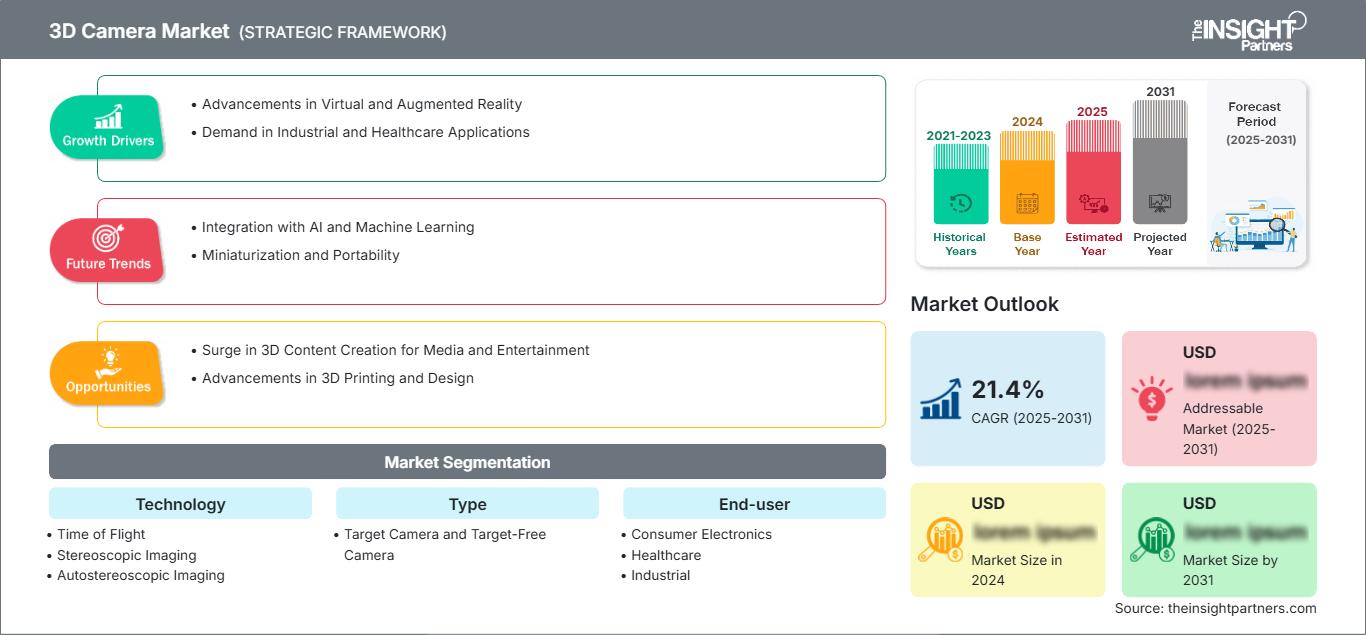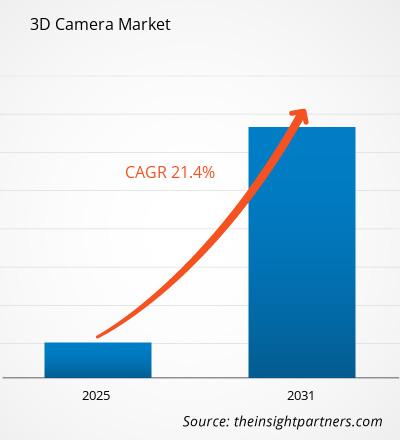3Dカメラ市場は、2025年から2031年にかけて年平均成長率21.4%で成長し、市場規模は2024年のXX百万米ドルから2031年にはXX百万米ドルに拡大すると予想されています。
レポートは、テクノロジー(飛行時間型、立体画像、裸眼立体画像、構造化光画像)、タイプ(ターゲットカメラとターゲットフリーカメラ)、エンドユーザー(民生用電子機器、ヘルスケア、産業、航空宇宙および防衛、建設、自動車、メディア&エンターテイメント)別にセグメント化されています。グローバル分析は、地域レベルと主要国でさらに細分化されています。レポートでは、上記の分析とセグメントの値を米ドルで提供しています。
レポートの目的
The Insight Partnersによる3Dカメラ市場レポートは、現在の状況と将来の成長、主な推進要因、課題、および機会を説明することを目的としています。これにより、次のようなさまざまなビジネス関係者に洞察が提供されます。
- テクノロジープロバイダー/メーカー: 進化する市場のダイナミクスを理解し、潜在的な成長機会を把握して、情報に基づいた戦略的決定を下せるようにします。
- 投資家: 市場の成長率、市場の財務予測、バリューチェーン全体に存在する機会に関する包括的なトレンド分析を実施します。
- 規制機関: 乱用を最小限に抑え、投資家の信頼と信用を維持し、市場の完全性と安定性を維持することを目的として、市場におけるポリシーと警察活動を規制します。
3Dカメラ市場セグメンテーション技術
- 飛行時間型
- 立体視画像
- 自動立体視画像
- 構造化光画像
タイプ
- ターゲットカメラとターゲットフリーカメラ
エンドユーザー
- 民生用電子機器
- ヘルスケア
- 産業用
- 航空宇宙および防衛
- 建設
- 自動車
- メディア&エンターテイメント
地域
- 北米
- ヨーロッパ
- アジア太平洋地域
- 中南米
- 中東およびアフリカ
レポートの一部、国レベルの分析、Excelデータパックなどを含め、スタートアップ&大学向けに特別オファーや割引もご利用いただけます(無償)
3Dカメラ市場: 戦略的洞察

- このレポートの主要な市場動向を入手してください。この無料サンプルには、市場動向から見積もりや予測に至るまでのデータ分析が含まれます。
3D カメラ市場の成長促進要因
- 仮想現実と拡張現実の進歩: 仮想現実 (VR) や拡張現実 (AR) などの没入型技術の需要の高まりは、3D カメラ市場の大きな推進力となっています。3D カメラはリアルな 3D コンテンツの作成に不可欠であり、VR および AR アプリケーションでの全体的なユーザー エクスペリエンスを向上させます。ゲーム、エンターテイメント、教育などの業界では、インタラクティブでリアルな環境を作成するために 3D カメラの採用が増えており、これらのエクスペリエンスをサポートする高品質の画像技術の必要性が高まっています。
- 産業およびヘルスケア アプリケーションでの需要: 3D カメラは、品質管理、検査、医療用画像処理などのアプリケーションで、産業およびヘルスケア分野でますます不可欠になっています。正確な 3D 画像をキャプチャする機能は、リバース エンジニアリング、スキャン、診断などのタスクの精度と効率の向上に役立ちます。これらの業界では 3D スキャンの採用が拡大しており、より高度な 3D カメラ ソリューションの需要が高まっています。
3D カメラ市場の今後の動向
- AI および機械学習との統合: 3D カメラ市場における重要なトレンドは、人工知能 (AI) と機械学習の統合です。これらのテクノロジは、画像処理、深度検知、物体認識を強化し、より高速で正確な 3D モデリングとスキャンを可能にします。AI 搭載 3D カメラは、顔認識、ジェスチャー制御、自律走行車などのアプリケーションでますます使用され、機能性と精度が向上しています。
- 小型化と携帯性: 3D カメラ技術の小型化も、成長傾向にあります。スマートフォン、ドローン、ウェアラブルなどの民生用電子機器に 3D カメラが採用されるにつれて、より小型で軽量、携帯性に優れたモデルへの移行が進んでいます。これらの小型でユーザーフレンドリーなデバイスは、高品質の 3D イメージングを実現するとともに使いやすさも提供するように設計されており、専門家と消費者の両方からますます人気が高まっています。
3D カメラの市場機会
- メディアとエンターテイメント向け 3D コンテンツ作成の急増:3D 映画、ゲーム、ライブストリーミングの人気に牽引され、メディアおよびエンターテイメント業界では 3D コンテンツの需要が高まっています。3D カメラを使用すると、映画製作者やコンテンツ クリエーターは高品質で没入感のある映像を制作できるため、映画制作、ゲーム、バーチャル イベントに新たなビジネス チャンスが生まれます。YouTube やゲーム コンソールなどのプラットフォーム向けの 3D コンテンツ作成の増加により、3D カメラの市場は拡大しています。
- 3D 印刷と設計の進歩:3D カメラは、特に設計、プロトタイピング、製造における 3D 印刷に不可欠なツールです。3D モデリングと複製のために、物理的なオブジェクトを正確にスキャンしてデジタル化することができます。自動車、航空宇宙、ヘルスケアなど、さまざまな業界で 3D プリントの使用が増えていることで、特にカスタム製造や製品開発などのアプリケーションにおいて、3D カメラ市場に大きな成長の機会が生まれています。
3Dカメラ市場の地域別分析
予測期間を通じて3Dカメラ市場に影響を与える地域的なトレンドと要因については、The Insight Partnersのアナリストが詳細に解説しています。このセクションでは、北米、ヨーロッパ、アジア太平洋、中東・アフリカ、中南米における3Dカメラ市場のセグメントと地域についても解説しています。
3Dカメラ市場レポートのスコープ
| レポート属性 | 詳細 |
|---|---|
| の市場規模 2024 | US$ XX million |
| 市場規模別 2031 | US$ XX Million |
| 世界的なCAGR (2025 - 2031) | 21.4% |
| 過去データ | 2021-2023 |
| 予測期間 | 2025-2031 |
| 対象セグメント |
By テクノロジー
|
| 対象地域と国 | 北米
|
| 市場リーダーと主要企業の概要 |
|
3Dカメラ市場におけるプレーヤーの密度:ビジネスダイナミクスへの影響を理解する
3Dカメラ市場は、消費者の嗜好の変化、技術の進歩、製品メリットへの認知度の高まりといった要因によるエンドユーザーの需要増加に牽引され、急速に成長しています。需要の増加に伴い、企業は製品ラインナップの拡充、消費者ニーズへの対応のためのイノベーション、そして新たなトレンドの活用を進めており、これが市場の成長をさらに加速させています。

- 入手 3Dカメラ市場 主要プレーヤーの概要
主なセールスポイント
- 包括的な調査範囲:本レポートは、3Dカメラ市場における製品、サービス、種類、エンドユーザーの分析を包括的に網羅し、包括的な展望を提供しています。
- 専門家による分析:本レポートは、業界の専門家とアナリストの深い理解に基づいて作成されています。
- 最新情報:本レポートは、最新の情報とデータ動向を網羅しているため、ビジネスの関連性を保証します。
- カスタマイズオプション:本レポートは、特定のクライアントの要件に対応し、ビジネス戦略に適切に適合するようにカスタマイズできます。
したがって、3Dカメラ市場に関する調査レポートは、業界のシナリオと成長の見通しを解読し理解するための先導役となります。いくつかの正当な懸念事項があるかもしれませんが、本レポートの全体的なメリットは、デメリットを上回る傾向があります。
- 過去2年間の分析、基準年、CAGRによる予測(7年間)
- PEST分析とSWOT分析
- 市場規模価値/数量 - 世界、地域、国
- 業界と競争環境
- Excel データセット
最新レポート
関連レポート
お客様の声
購入理由
- 情報に基づいた意思決定
- 市場動向の理解
- 競合分析
- 顧客インサイト
- 市場予測
- リスク軽減
- 戦略計画
- 投資の正当性
- 新興市場の特定
- マーケティング戦略の強化
- 業務効率の向上
- 規制動向への対応




















 無料サンプルを入手 - 3Dカメラ市場
無料サンプルを入手 - 3Dカメラ市場